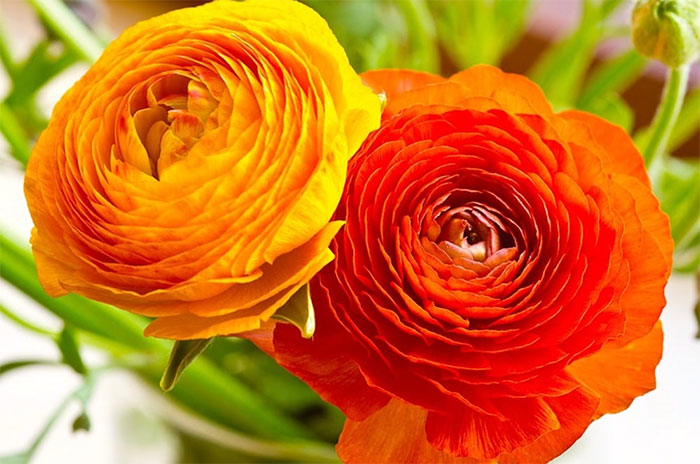Ranunculus Flower Symbolism Facts & Meaning: Zodiac, Superstitions, Dreams, and Legends
I
Ranunculus Flower Facts
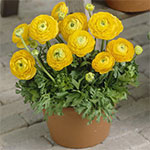
The Ranunculus Flower is a delicate, springtime flower that performs best where winters are relatively mild and springs are long and cool. It grows up to 30 cm in height with fern-like leaves and multi-layered ruffled petals in rainbow hues – from pastel pinks to fiery reds, they also range from white, cream, yellow, orange, and purple. Its paper-thin petals resemble the texture of crepe paper.
Each flower has between 100 to 130 petals, making them voluminous and abundant in appearance. As the petals peel one by one, it slowly reveals its center having a darker tone. The Ranunculus Flower adds not just vibrancy and texture to any home but a splash of color as well.
The Ranunculus belongs to the Ranunculaceae family with over 600 different species of flowers which includes buttercups, spearworts, and water crowfoots. The most popular ones are the Florist Buttercup and Ranunculus asiaticus which is most commonly known as the Persian Buttercup.
The name came from the Latin words, “rana” meaning “frog”, and “unculus” meaning “little.” Its bulbs flourish near bodies of water and naturally grow along streams, hence the nickname – Little Frog. This flower has a long stalk and long-lasting life which makes it ideal for cutting and if properly looked after, it can live for 8 days up to 2 weeks in a vase.
When it is cold, the flower keeps itself warm by forming the petals into a cup shape to collect sunlight which creates a magnificent spot that warms both insects and bugs alike. Furthermore, yellow Ranunculus petals have mirror flat cells that bounce back light which means that they reflect UV light – a special trick that makes it look vibrantly yellow and helps attract bees.
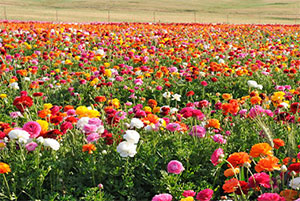
II
Ranunculus Flower Uses
The Ranunculus Flower is well-known for its medicinal properties. Native Americans use the flower’s roots to treat skin ailments such as boils and warts. A poultice of Ranunculus buttercup flower can also be quite soothing for persons who suffer from eczema.
Ranunculus buttercup essential oils can also be used for aromatherapy treatment as it is sweet, bringing peace. In traditional medicine, dried petals of Ranunculus buttercups were used to ease pains and strains of muscle tension, to soothe body aches and sore joints.
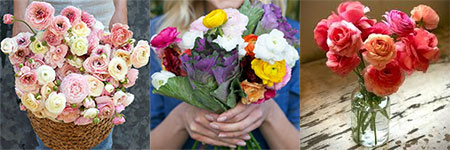
III
Ranunculus Flower History
The Ranunculus Flowers are endemic plant which originated from Central Asia. They were introduced to Europe alongside the Anemones and Tulips during Queen Elizabeth I’s reign in the 16th century.
The following century, it was found in the gardens of Sultan Mohammed IV. Hence, the flower became renowned and achieved a great reputation all over the world.
It is said, however, that the flower was first discovered in Europe during the 13th century in the Holy Land by the first Crusaders of Saint-Louis or Louis IX but at this time, the Ranunculus had gone almost unnoticed until a bulb drew attention in the gardens of the rulers of the Ottoman Empire a few years later.
IV
Ranunculus Flower Positive Symbolism
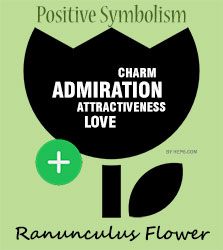
The Ranunculus Flower carries symbolisms with deep-rooted meanings across various cultures of every generation. This flower radiates charm, attractiveness, and admiration. You can send a bouquet to any person you adore and find precious. Also, you can even buy one for yourself as it represents all kinds of love and adoration including self-love.
V
Ranunculus Flower Negative Symbolism
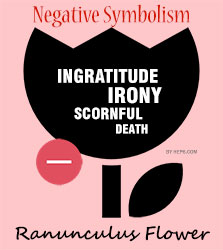
Although the Ranunculus Flower has many positive symbolisms, there are, of course, some negative ones as well. The Ranunculus sardous, or most commonly known as Hairy Buttercup, is a flower that is said to be capable of creating or driving people into madness to symbolize irony, scornful laughter, and even death.
What’s more is that in other rural areas, this bloom is just considered a weed as it tends to grow abundantly. In certain communities, receiving this flower can actually mean ingratitude.
VI
Ranunculus Flower Cultural Symbolism
The Ranunculus Flower symbolizes love and admiration in many different cultures even from the past and present. During the Victorian era, people would always send these flowers to their special someone. Nowadays, they remain immensely popular in the form of a gift as receiving a bouquet of these flowers is bound to brighten someone’s day.
VII
Ranunculus Flower Zodiac Sign

It is believed that Geminis have a duality to them just like the Ranunculus.
Geminis have showy personalities and are outspoken whilst the Ranunculus Flower often symbolizes charm and attractiveness – traits that are abundant in Geminis.
VIII
Ranunculus Flower in Dreams
Dreaming of Ranunculus Flowers carries different meanings depending on what you dreamt of. For instance, a dead Ranunculus means you are being held back from achieving your objectives. When a beautiful Ranunculus appears in your dream, it indicates spiritual insight in your waking life.
A luxuriant Ranunculus, however, indicates that light needs to be shed on some dark situations. In irony, a sighting of a Ranunculus in bloom refers to a sense of insecurity. Whereas, a multi-colored Ranunculus symbolizes your awareness of your present state of mind and feelings.
IX
Ranunculus Flower Omens and Superstitions
Long ago, people used to think that the rich, yellow color of butter was caused by the yellow Ranunculus (simply called Buttercups) eaten by cows. This, of course, is incorrect. They might be great to look at but they are toxic to humans and animals when eaten fresh as it causes gastric upset.
X
Ranunculus Flower Mythology and Folklore
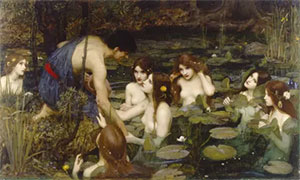
The legends and mythologies of the Ranunculus Flower are both fascinating yet quite tragic. In Persian culture, they have a tale of a young prince dressed in green that fell in love with a beautiful nymph. He was so lovesick that he would visit her and sing to her through day and night. The other nymphs eventually got fed up and finally turned him into a Ranunculus Flower.
In another, more dramatic version of this tale, his love, and admiration were never returned by his beloved nymph. In the end, he dies of a broken heart and a Ranunculus then blooms in the place where he died.
The Native Americans on the other hand have a different spin on the lore of this peculiar flower. They refer to it as “Coyote Eyes”. In the story, a coyote got bored and decided to entertain himself by taking out its eyes, throwing them up in the air, and catching them as if they were just a normal pair of balls. He kept this up until an eagle suddenly swooped in and snatched the coyote’s eyes. Woeful and dismayed, the now blind coyote wandered around the fields of Ranunculus buttercups until he found two that perfectly replaced his stolen eyes.

